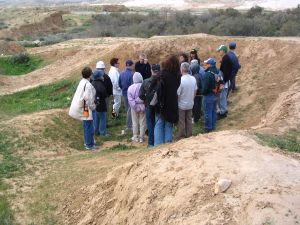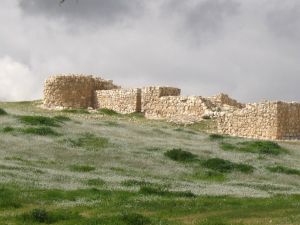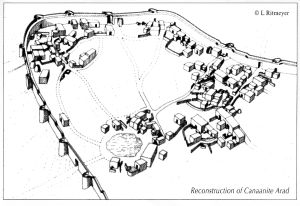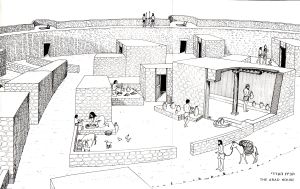We finally went on our first real excursion with Avner Goren yesterday, in our Man and the Desert course, after it was cancelled last month due to rain. Bish chickened out at the last minute. I reckoned it was the early wake-up that broke him. So it was just R.T. and me. And a bunch of other people of course.
Listen, if any of you ever get an opportunity to listen to this person speak, in a language you can understand, do not hesitate. He’s wonderful. He brings the distant past to life in such a vivid, exciting way.
We visited two sites on the edge of the desert. One was a hole in the ground called Beer Tzafad on the outskirts of Beer Sheva.

It’s an interesting archeological site dug in the 1950’s that sadly has been neglected over the years.
The other was Tel Arad, which is desert today, but is believed to have had more rain 5000 years ago and therefore was on the edge of the desert.

See how green it all is. Hard to believe it will all dry up soon, and if you visit there in the summer all you’ll see is yellowy-brown land. The white stuff is flowers, by the way.
Naturally, the batteries of my camera finished just after I took this and before we had actually entered the site. So I’ve googled. There are plenty of photographs, although everyone seems more interested in the Israelite fortress with its temple, than in the Canaanite city which absolutely blew me away.
For one thing this was a big place, considering how long ago it was built (3100 BC).

A planned city with a great city wall, complete with watchtowers, some rounded and some square. The communal area includes buildings believed to have been a palace and a temple area. The roads were planned and there was even a primitive water system (Not the well you can see in some of the photos. That was from the Israelite period, 1400 years later). In Tel Arad you can see the typical Canaanite dwelling of the time, which is called the Arad house by archeologists.

(The reconstructions are by L. Ritmeyer, from the Israel Nature and Parks Authority leaflets. I hope Mr. Ritmeyer will not mind my use of his drawings here. They're too small to be copied and used elsewhere)
After Arad was abandoned and ruined between 2000 – 2400 BC probably as a result of economic changes that were going on in Egypt, Arad’s main market, it wasn’t built again as a city. The Israelites later built the fortress, as I’ve said, on one corner of it. This apparently made it an interesting dig, because the findings from that period were not buried under generations of later constructions.
Contrary to popular belief, Avner says that Jericho was not the oldest city in the world. The wall, dating back to 5000 BC, that had thought to have been a city wall turned out to have been a protective barrier to stop the water from the Jordan River from flooding the village that was there. The town came much later. Even the archeologist who had made the original claim accepted her mistake. The Palestinians continue to market Jericho as the oldest city though, for tourism reasons, and who can blame them?
Arad was one of the earliest cities though, and the site is very impressive, especially when consumed along with Avner’s explanations, and even though only a small part of it has been excavated.
I must say I’m looking forward to an evening lecture we’re having with Avner as part of the course, the week after next.